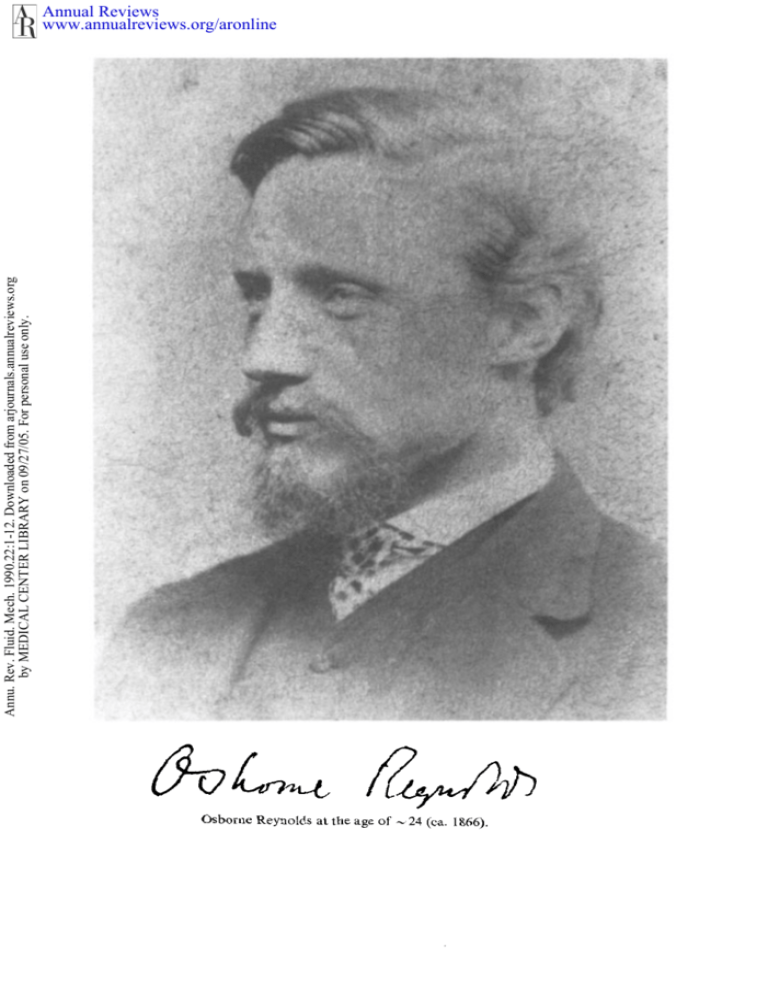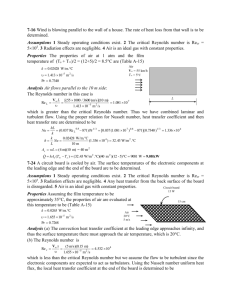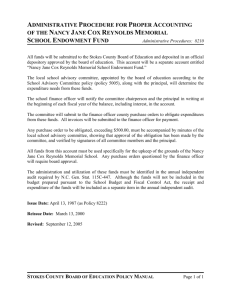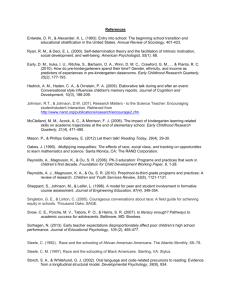
Annu. Rev. Fluid. Mech. 1990.22:1-12. Downloaded from arjournals.annualreviews.org
by MEDICAL CENTER LIBRARY on 09/27/05. For personal use only.
Annual Reviews
www.annualreviews.org/aronline
Osborne Reynolds at the age of -24 (ea. 1866).
Annual Reviews
www.annualreviews.org/aronline
Annu.Rev. Fluid Mech.I990, 22: I-II
Copyright©1990by AnnualReviews1no, All rights reserved
Annu. Rev. Fluid. Mech. 1990.22:1-12. Downloaded from arjournals.annualreviews.org
by MEDICAL CENTER LIBRARY on 09/27/05. For personal use only.
NOTE ON THE HISTORY OF
THE REYNOLDS NUMBER
N. Rott
Department of Aeronautics and Astronautics, Stanford University,
Stanford, California 94305
1.
NAME
ORIGINS
In 1908, Arnold Sommerfeldpresented a paper on hydrodynamicstability at
the 4th International Congress of Mathematicians in Rome(Sommerfeld
1908). In the equation knowntoday as the Orr-Sommerfeld equation, he
introduced a number R as "eine reine Zahl, die wit die Reynolds’sche
Zahl nennen wollen." (freely translated: "R is a pure number; we will call
it the Reynolds number.") The terminology introduced by Sommerfeld
has not changed ever since, and the use of the expression "Reynolds
number"has spread into all branches of fluid mechanics.
Actually Sommerfeld’s work is not foremost in one’s mind when one
thinks of the direct continuation of the ideas set forth by OsborneReynolds
in 1883 (Reynolds 1883). This is probably the reason that Sommerfeld’s
use of the expression "Reynolds number" was generally forgotten before
von Kfirmfin (1954) drewattention to it in his book Aerodynamics."Selected
Topics in the Light of Their Historical Development.He referred there to
work by Sommerfeldfrom the year 1908 but did not mention the title and
the place of publication. Von Kfirmfin returned to this subject in his
paper published in the Albert Betz anniversary issue of the Zeitschriftfiir
Flugwissensehaften (von Kfirmfin 1956). Unfortunately the reference there
is to Sommerfeld’s(1904) paper on the Reynolds theory of lubrication.
that work the inertial terms are neglected, and the notion of the Reynolds
numberis neither needed nor used. Whileit is not difficult to reconstruct
the facts by the use of yon Kfirmfin’s book, it maybe useful, nevertheless,
to have these sources collected and recollected here again.
I also wish to correct and to explain an incorrect statement that I made
on this subject in an earlier article in this series (Rott 1985). There1 stated
1
0066-4189/90/0115-0001 $02.00
Annual Reviews
www.annualreviews.org/aronline
Annu. Rev. Fluid. Mech. 1990.22:1-12. Downloaded from arjournals.annualreviews.org
by MEDICAL CENTER LIBRARY on 09/27/05. For personal use only.
2
ROTT
that the expression "Reynolds number" was introduced by Prandtl. This
remark was based on personal recollections of conversations with Jakob
Ackeret. Given the fallibility of memoriesthat are not supported by tangible evidence, this remark should never have been made. Thanks are due
to numerous colleagues and friends who drew myattention to the facts
uncovered by yon K~rm~n.However,I have decided to investigate, after
having madethe allegations, the actual role of Prandtl in the history of
the Reynoldsnumber. This has led also to studies of the early history of
the notion and notation before Sommerfeld and Prandtl. A summaryof
myfindings follows.
Manypeople in fluid mechanics, if asked to guess, wouldbe inclined to
attribute the expression "Reynolds number" to Blasius. His work is the
first that is fully devoted to the extraction from experimentsof a function
that, according to Reynolds’ similarity law, depends only on the Reynolds
number.The reader consulting the originals will find that Blasius actually
uses the expression "Reynolds number," but only twice in the first publication of his results (Blasius 1912, pp. 640, 642). In the subsequent
extended VDIreport, he uses the expressions again in the corresponding
passages (Blasius 1913, pp. 7, 9).
Prandtl’s role in the history of the Reynoldsnumber,as revealed in his
collected works, begins with his early paper on the Reynolds analogy
(Prandtl 1910). There he introduces "die in der Hydrodynamikbekannte
Reynolds’sche Zahl" but calls it later simply 4. The words "known in
hydrodynamics"refer to the general field. Thus it cannot be ascertained
whether Prandtl has chosen his words following Sommerfeldor some other
source knownto him, or whether he made this choice independently. On
the other hand, Prandtl’s influence on Blasius is highly probable.
In his encyclopedia article on "Fl~issigkeitsbewegung," Prandtl (1913)
writes more deliberately: "Die vorstehende Grrsse, eine dimensionslose
Zahl, wird nach dem Entdecker dieses ,~hnlichkeitsgesetzes,
Osborne
Reynolds, die Reynolds’sche Zahl genannt." ("The forementioned
quantity, a nondimensional number, is namedafter the discoverer of this
similarity, OsborneReynolds, [and is called] the Reynolds number".) I am
indebted to Professor Itiro Tani for pointing out this passage (in Volume
3, p. 1445of the collected works), as well as for other information used in
this note.
A study of Prandtl’s collected works also showsthe crucial role that he
and his coworkers in Gfttingen played in the application of hydrodynamic
similarity to the drag problem. In the years around 1912, an international
dispute erupted over the drag of spheres, with Prandtl and Eiffel (who made
the famous drop experiments from his tower) as the main protagonists. In
1913, Lord Rayleigh noted briefly that this discussion should be considered
Annual Reviews
www.annualreviews.org/aronline
Annu. Rev. Fluid. Mech. 1990.22:1-12. Downloaded from arjournals.annualreviews.org
by MEDICAL CENTER LIBRARY on 09/27/05. For personal use only.
HISTORYOF THE REYNOLDS
NUMBER 3
in the light of hydrodynamicsimilarity (Rayleigh 1913). He credited Stokes
before Reynoldswith the discovery of this notion. Stokes indeed noted the
similarity properties of his basic equations of viscous flow together with
their derivation in 1850. The resolution of the drag problem, however,
called for the specific similarity law established by Reynolds(1883) for the
pressure drop in pipes, which is also applicable--rnutatis mutandis--to
the drag problem. Interestingly, it was Lord Rayleigh who made what is
almost certainly the first reference ever to Reynolds’similarity law, in the
introduction to his paper "On the question of the stability of the flow of
fluids" (Rayleigh 1892). (This is discussed later.)
The resolution of the sphere drag problem was completed by Prandtl in
his paper of 1914, where he introduced a new concept that complemented
his boundary-layer theory--namely, the idea of the transition of the
boundary layer from laminar to turbulent at a critical Reynolds number
(Prandtl 1914). Prandtl made here no more explanatory commentson the
usage of this word. After his paper it becamecommonknowledgethat the
drag coefficient depends on the Reynolds number, a term that became a
household word in aerodynamics and aeronautics. The general acceptance
of the term and of the notion came muchlater in hydraulic engineering,
in spite of the fact that a textbook on hydraulics by von Mises appeared
in 1914 that fully exploited Reynoldssimilarity (albeit without using the
term "Reynolds number"). The memoryof this book (von Mises 1914),
which is nowlargely forgotten, is kept alive in Rouse& lnce’s History of
Hydraulics (Rouse & Ince 1957).
After WorldWarI, a treatise on similarity and its use for modelexperiments appeared in the Jahrbuch der Schiffbautechnischen Gesellschaft by
Moritz Weber, Professor of Naval Architecture in Berlin (Weber 1919).
As noted by Rouse & Ince, Weber not only put the Reynolds number to
use but also introduced the Froude number and a new number involving
capillarity, which later was namedfor him. This was apparently the beginning of a new era in the use of names for nondimensional numbers.
Reference has been made here repeatedly to the seminal paper of Reynolds (1883). There he gave, by dimensional analysis, unprecedented applications that led to specific results: He introduced the notion of the critical
Reynolds numberand established the similarity law for the pressure drop
in pipes. The early history of these ideas is discussed in the following
sections.
2.
REYNOLDS’
EXPERIMENTS
FLOW-VISUALIZATION
Reynolds gave a visual demonstration of the transition from laminar to
turbulent flow in a pipe, using an experimental setup that is still popular
Annual Reviews
www.annualreviews.org/aronline
Annu. Rev. Fluid. Mech. 1990.22:1-12. Downloaded from arjournals.annualreviews.org
by MEDICAL CENTER LIBRARY on 09/27/05. For personal use only.
4
ROTT
today. Figure 1, which is reproduced from Reynolds (1883), shows
artist’s concept of the original device. An elevated platform permits the
use of a siphon that is high enoughto reach the critical velocities; the valve
at the exit is manipulated by a lever that extends to the platform. Water
is drawnfrom a glass-walled box into a glass tube, together with a filament
of dye. The tube has a trumpet-shaped inlet. Readings of the water level,
accurate to 1/100 of an inch, were used to determine the velocity.
The dye filaments at transition are reproduced in many texts, using
Reynolds’original drawings;but as his apparatus is still in existence at the
University of Manchester, modern photographs can also be obtained. A
series is shownin Van Dyke’s (1982) Albumof Fluid Motion, with a telling
comment:"Moderntraffic in the streets of Manchester made the critical
Reynolds number lower than the value 13,000 found by Reynolds."
Cautioning remarks were already voiced by Reynolds himself concerning the importanceattached to the actual value of this critical number.
Figure 1 Artist’s concept of Reynolds’ flow-visualization experiment.
Annual Reviews
www.annualreviews.org/aronline
Annu. Rev. Fluid. Mech. 1990.22:1-12. Downloaded from arjournals.annualreviews.org
by MEDICAL CENTER LIBRARY on 09/27/05. For personal use only.
HISTORYOF THE REYNOLDS
NUMBER 5
It was clear to him that he needed a carefully shaped inlet to avoid eddies
created at the entrance of his tube. He also wrote (Reynolds1883, p. 955):
"The fact.., that this relation has only been obtained by the utmost care
to reduce the external disturbances in the water to a minimummust not
be lost sight of." This is a reminder repeated from p. 943, where he
notes (we revert to present-day terminology) that turbulent flow has been
observed at much lower Reynolds numbers; he continues: "This showed
that the steady motion was unstable for large disturbances long before the
critical velocity was reached, a fact which agreed with the full-blown
manner in which the eddies appeared."
This discussion admits the interpretation that, by more careful experiments, an upper critical Reynolds number could be found that is the
stability limit for small disturbances. Reynolds’experiments were repeated
a quarter-century later by V. Walfrid Ekman,who visited Manchester to
use Reynolds’ original equipment. By smoothing the wooden trumpetshaped inlet, he was able to reach critical Reynolds numbersup to 44,000
(and later more) but found strong scatter approaching these high values.
He conjectured (Ekman1910) that the flow is stable for small disturbances.
In a footnote on the subject of the existence of the upper critical Reynolds
number, Ekmannotes: "It appears that Reynolds himself was somewhat
doubtful on this point. It is not easy to find out from his paper what his
final opinion really was."
The modern point of view, as formulated by Drazin & Reid (1981, p.
219), is that investigations in this century "have led to the belief that
Poiseuille flow in a circular pipe is stable with respect to axisymmetric
disturbances. There is also increasing evidence that it is stable with respect
to non-axisymmetricdisturbances .... "Aninfinite upper critical Reynolds
numberexplains the experimental results. However,a full explanation has
also to account for the stability in the varying environment of an inlet,
wherethe Poiseuill¢ profile is not yet fully developed. "
In summary, the simplest and most successful visualization of flow
transition devised by Reynolds is not, at the same time, the simplest
demonstration from the theoretical point of view.
Reynoldsfirst presented his experimental results in a form that did not
take full advantageof the clarification of the concepts that he had obtained
by dimensional analysis. (A close account is given in Lamb1932.) For
instance, Reynolds wrote for his upper critical velocity the expression
U = P/BD, where D is the diameter, P = V/Vo is the kinematic viscosity v
of water divided by its value v0 (=0.01779 cm2 s -1) at 0°C, and P is a
function of the temperature as measured by Poiseuifle. Finally, B is
the parameter for which the critical value is determined by experiment.
Reynolds found that B is about 43.79 in seconds per square meter units.
Annual Reviews
www.annualreviews.org/aronline
6
Ro~
Annu. Rev. Fluid. Mech. 1990.22:1-12. Downloaded from arjournals.annualreviews.org
by MEDICAL CENTER LIBRARY on 09/27/05. For personal use only.
The Reynolds number is the reciprocal of the product Bvo; this gives
12,830.
In early classic (pre-Reynolds) hydraulics, measurementsof the temperature dependence of the viscosity in water were often combined with
studies of the flow resistance in pipes. Reynoldsactually used the function
P to extend the scope of his experiments: Critical velocities obtained for
5°C and 22°C were compared and found to have the ratio of about 1.4,
in accordance with Poiseuille’s formula for P. This complementedthe
experimentswith different tube diameters of 1, 1/2, and 1/4 inch.
3.
THE
CRITICAL
REYNOLDS
NUMBER
In his original investigations Reynolds (1883, p. 946) came to the conclusion that "there must be another critical velocity, at which previously
existing eddies would die out, and the motion becomesteady as the water
proceeded along the tube. This conclusion has been verified."
Reynolds determined this critical velocity by measuring the pressure
drop in a 5-ft section at the end of a 16-ft pipe. He found the pressure loss
to be proportional to the first power of the velocity for low speed but
varying with a higher power beyond a "lower critical velocity," which
occurred for the value B = 278 s m-2 of his parameter defined above. This
parameter value corresponds to a "lower critical" Reynolds number of
2020. (Later, this was simply called the critical Reynolds number.) The
supercritical pressure-loss dependenceon the velocity was found to follow
a power law with the exponent 1.723.
Reynolds returned to the discussion of these results in 1895, when he
first presented critical values by using explicitly the Reynolds number
proper (Reynolds 1895). He called it K and based it (as an engineer always
would, reading from a drawing or a caliper) on the pipe diameter. He
quoted for the critical K of transition a value between 1900 and 2000,
based on his ownexperience.
Reynolds’ purpose in his 1895 paper was to calculate K, or at least to
find a lower bound for K, by identifying dissipation with what is today
called turbulent production. He thus created the foundation of the main
branch of modern turbulence theory by writing down the "Reynoldsaveraged" equations of motion. The history of these ideas is beyond the
scope of this note.
Reynoldshad already observed that plugs of laminar and turbulent flow
alternate in a pipe near the critical Reynolds number, causing what is
today called "intermittency" of the flow. For this reason Reynolds, as well
as experimenters after him, preferred to give an interval for the critical
Reynolds number instead of .an "exact" value; it was found practically
Annual Reviews
www.annualreviews.org/aronline
Annu. Rev. Fluid. Mech. 1990.22:1-12. Downloaded from arjournals.annualreviews.org
by MEDICAL CENTER LIBRARY on 09/27/05. For personal use only.
HISTORY
OF
THE REYNOLDS
NUMBER
7
impossible to makean inlet sufficiently "rough" so that a weakly supercritical flow wouldstart without any laminar spots.
Intermittency is easily demonstrated by letting a horizontal jet emerge
froma near-critical pipe flow. Thejet oscillates i.e. it reaches different distances as laminar and turbulent flow alternate at the exit. As explained by
Jttlius Rotta (1956), this occurs because for the samemassflow, laminar and
turbulent parts do not have the same impulse. The laminar part has the
higher impulse and thus movesfarther horizontally whenit emergesas a jet.
Oscillations are strongly accentuated if they are coupled to changes of
the mass flow. This always happens whenthe flow resistance in the nearcritical pipe, where laminar and turbulent flow plugs alternate, is a significant part of the overall pressure drop in the system. Experiments in
such systems are not suitable for the determination of the critical Reynolds
number. To assure the constancy of the mass flux, Rotta experimented
with a (low-pressure) airflow regulated by a sonic throat. Velocity and
intermittency were determined by hot-wire measurements. Rotta’s observations, supported by theoretical arguments, showedthat the supercritical
turbulent plugs grew mostly at their front end. He proposed to define the
critical Reynolds number by the constancy of the intermittency factor.
However, as the growth speed became very slow approaching the critical
Reynolds number, reliable measurements would have required a tube of
excessive length. Rotta measured a 2%excess of the plug growth speed
over the mean speed at a Reynolds number of 2300, from which he
extrapolated to a putative critical Reynoldsnumberof 2000. (This happens
to be the value first proposed by Reynolds.)
For pipes without a streamlined inlet, the critical value quoted in most
contemporary textbooks is 2300.
4.
THE
POWER
LAW
Reynolds determined the critical Reynolds number by the change of the
dependence of the pressure loss on velocity. As already noted, he found
for turbulent flow a velocity powerlaw with the exponent 1.723, valid for
his experimentsover a range of I to 50 (Reynolds1883, p. 975). He actually
wrote down(on the same page) the similarity law for the pressure drop
its full generality, namely(in present-day notation)
L
1 2
p(L)--p(O) = ~f(R ),
R = pUD-’- UD
#
v ,
and then considered the special functionf(R) cR-".
Annual Reviews
www.annualreviews.org/aronline
Annu. Rev. Fluid. Mech. 1990.22:1-12. Downloaded from arjournals.annualreviews.org
by MEDICAL CENTER LIBRARY on 09/27/05. For personal use only.
8
ROTT
Representation of experimental results by a power law has led, during
its long history, to the discoveryof analytic relations at best and to useful
local approximations at least. Dimensional analysis extends the scope
and power of this tool immensely. The experimentalist then is guided by
knowingthat the exponents obtained for the different physical variables
that enter the similarity parameterhave to fulfill certain relations.
Reynolds was the first to use the power law in this sense. Manylaws
with odd exponents were established before him without consideration of
dimensionality or similarity. Wecan understand why Reynolds did not
see the necessity of quoting them.
Lord Rayleigh (1892) pointed to the two limits of Reynolds similarity
whereexact explicit laws follow: The classical slow-flow result (n = 1)
independent of density, while the limiting velocity-square law (n = 0) for
turbulent flow at high speeds is independent of viscosity. Rayleigh considered the latter case as a further illustration of his principle that inviscid
solutions and solutions obtained in the limit of vanishing viscosity can
be fundamentally different. He proceeded to show that inviscid stability
calculations for simple channel flows do not lead to unstable solutions.
The next discussion of Reynolds’ paper of 1883 (but with no mention
of his work of 1895) appeared in 1897. That it was "next" is conjectured
because the author, G. H. Knibbs of the University of Sydney, apparently
was very conscientious in searching the literature, and he quotes only Lord
Rayleigh’s paper dealing with Reynolds’ work. Knibbs (1897) could not
accept Rayleigh’s point of view and, moreover, he rejected Reynolds’
similarity principle. To analyze such errors is futile. With somegood will,
one can say that Knibbs attempted (following older ideas) to establish
formulas both for open channels and for pipes, using a commonprinciple.
Whenboth viscosity and gravity play a role, then two empirical exponents
are required for the most general power law, and the guidance given by
Reynolds’ similarity is lost. Knibbs described the history of the many
contributions to the power law and took issue with Reynolds for ignoring
them.
Wehave already sided with Reynolds and adopt now an idea of Blasius
for the selection of references: Onlypapers are quoted in which the powerlaw dependence is stated both for the velocity U and for the diameter D,
in a way that is compatible with Reynolds similarity. According to the
formula that states the similarity law (see above), the difference of the
exponents of U and of D has to be 3. Then, only one author is left on
Knibbs’ reference list, namely the Germanhydraulic engineer Gotthilf
Heinrich Ludwig Hagen (1797-1884), of Hagen-Poiseuille fame.
Knibbs was aware of the compatibility of Hagen’s empirical results with
Reynolds’ theory, but this was for him only an isolated case. Hagen
Annual Reviews
www.annualreviews.org/aronline
Annu. Rev. Fluid. Mech. 1990.22:1-12. Downloaded from arjournals.annualreviews.org
by MEDICAL CENTER LIBRARY on 09/27/05. For personal use only.
HISTORY OF THE REYNOLDS NUMBER
9
obtained his results without knowingabout similarity; he found that the
best fit to the averaged results of his measurementswith three different
tube diameters was obtained with the exponent n = 1/4, the same as
today’s accepted value. Actually, Hagengave credit to the Germanengineer Reinhard Woltman(1746-1822) for first proposing the exponent 1.75
for the velocity, in work dating back to 1790. The fact that a power less
than 2 describes pressure losses in pipes was already observed earlier, by
Pierre Louis Georges Du Buat (1734-1809), one of the great hydraulicists
of eighteenth-century France. For more historical material, the reader may
want to consult the eminently readable book of Rouse & Ince (1957).
Hagen’s measurements were published in 1854 (Hagen 1854); in the
same paper he made an observation for which he is probably best known.
Knibbsquoted the wholepassagein its original form: It is the first description of the transition betweenlaminar and turbulent flow in a pipe. Hagen
used sawdust ("S~gesp~hne") as a means of flow visualization;
later
(Hagen 1869), he recommendedthe use of filings of dark amber. Without
the help of similarity laws, however, no general conclusions could be
drawn.
After the 1897 paper of Knibbs, it took 15 more years before Blasius
reintroduced Reynoldssimilarity to the powerlaw for pipes. In the meantime, however, important experiments were conducted with new means,
and Hagen’s feat was repeated on a grand scale. Pressure drop in (smooth)
pipes was measured by two graduate students at Cornel1 University,
August V. Saph and Ernest W. Schoder, Jun., working at the Hydraulic
Laboratory (founded in 1899). Their results were published in the Transactions of the AmericanSociety of Civil Engineers (Saph &Schoder 1903).
They fitted their data, both for velocity and diameter, with n = 1/4 but
did not consider the dependenceon viscosity. Blasius only had to introduce
the kinematic viscosity of water to obtain the nondimensional constant
that multiplies the power law. (Actually he also made experiments of
his own and surveyed data from many other sources. Reynolds’ own
experimentsdid not turn out to be useful for the nondimensionalconstant.)
The paper of Saph & Schoder (1903) was published together with
written discussion of their work by leading hydraulicists. Oneof them, A.
Flamant of France, pointed out that he had already obtained the formula
of Saph &Schoder in 1892. This lead proved to be interesting. Flamant’s
influential textbook Hydraulique first appeared in 1891. In the second
edition (Flamant 1900), he gave a "new formula" that he obtained
inspecting existing results for accuracy and convenience;it agreed with the
results of Saph & Schoder. Flamant also mentioned Reynolds’ results in
his book: He quoted Reynolds’ power-law exponent 1.723 but not the law
of similarity.
Annual Reviews
www.annualreviews.org/aronline
Annu. Rev. Fluid. Mech. 1990.22:1-12. Downloaded from arjournals.annualreviews.org
by MEDICAL CENTER LIBRARY on 09/27/05. For personal use only.
10
ROTT
Finally, around 1910, the acceptance of Reynolds similarity began to
spread. In 191 l, von K~irm~inexhorted certain authors whowere measuring pressure loss in pipes for different fluids to be mindful of Reynolds
similarity (von K~trm~tn1911). Blasius wrote in the extended version
his paper (BIasius 1913, p. 5) that the Reynolds law "has not penetrated,
as of today, into the pertinent fields of engineering" (in the original: "ist
in die einschlfigigen Gebiete der Ingenieurwissenschaften bis heute noch
nicht eingedrungen"). His paper becameinfluential in leading to a change,
and it was widely used in aeronautical and mechanical engineering.
The combination of the powerlaw with similarity considerations proved
to be a valuable tool for further developments in the early stages of
turbulence theory and has led to results of lasting importance for engineering applications. The connection between the wall stress, the dynamic
pressure, and the Reynolds number, as given by Blasius’ formula for pipe
flow, is directly applicable to the turbulent boundarylayer on a fiat plate
and can be extended to a multitude of interesting cases.
A higher level of sophistication in the application of these tools was
reached with the derivation of the 1/7-power law for the turbulent velocity
profile. However,this also signaled the demise of the power-lawera: Both
discoverers of the 1/7-power law, Prandtl and yon K~rm/tn, moved.onto
the logarithmic velocity distribution.
(According to a personal communication from Ackeret, Prandtl never believed in the deep physical
significance of simple fractions as exponents: He wanted to find a
logarithm.)
Actually, neither Hagennor Reynoldsfelt particularly committedto the
use of the power law. Hagen, whowas also a practical engineer and builder
of public works, discussed in 1869 other types of formulas (Hagen 1869).
For Reynolds, the power law was mostly a convenient tool for the determination of transition. He had continued interest in the critical Reynolds
numberand inspired other researchers to measure it. He remained active
until 1905, when he retired from the position to which he was appointed
in 1868: Professor of Engineering at the University of Manchester.
5.
EPILOGUE
Reynoldsbegins his 1883paper by stating: "The results of this investigation
have both a practical and a philosophical aspect." This could be a useful
quotation for instructors whoteach a first course in fluid mechanics to
juniors in an engineering college. There is a yearly battle going on for
students’ minds; history might help to convince them that the use of the
Reynolds number as an independent variable is an application of a basic
truth, and not just a useful convention for a handy diagram.
Annual Reviews
www.annualreviews.org/aronline
HISTORY OF THE REYNOLDS NUMBER
l1
ACKNOWLEDGMENTS
Vital information provided by Professor Itiro Tani, as well as help and
encouragement given by Professors Milton Van Dyke, John F. Kennedy,
Arthur F. Messiter, Frederick S. Sherman, and John V. Wehausen, are
thankfully acknowledged.
Annu. Rev. Fluid. Mech. 1990.22:1-12. Downloaded from arjournals.annualreviews.org
by MEDICAL CENTER LIBRARY on 09/27/05. For personal use only.
Literature Cited
Blasius, H. 1912. Das Aehnlichkeitsgesetz
bei Reibungsvorg/ingen. VDI-Z. 56: 63943
Blasius, H. 1913. Das Aehnlichkeitsgesetz
bei Reibungsvorgiingenin Fliissigkeiten.
VDI Mitt. Forschumdsarb. No. 131.39 pp.
Drazin, P. G., Reid, W. H. 1981. Hydrodynamic Stability. Cambridge:Univ. Press
Ekman, V. W. 1910. On the change from
steady to turbulent motion of liquids. Ark.
Mat. Astron, Fys. 6(12): 1-16
Flamant, A. 1900. Hydraulique. Paris:
Brranger. 2rid ed.
Hagen, G. 1854. Ueber den Einfluss der
Temperatur auf die Bewegung des Wassers in R/Shren. Math. Abh. Akad. Wiss.
Berlin, pp. 17 98
Hagen, G. 1869. Ueber die Bewegung des
Wassers in cylindrischcn,
nahe horizontalen Leittmgen. Math. Abh. Akad.
Wiss. Berlin, pp. 1-29
Knibbs, G. H. 1897. On the steady flow of
water in uniform pipes and channels. J. R.
Soc. N.S.W. 31:314-55
Lamb, H. 1932. Hydrodynamics. Cambridge:
Univ. Press. 6th ed. Reprinted, 1945, by
Dover (New York)
Prandtl, L. 1910. Eine Beziehung zwischen
W~trmeaustausch und Str6mungswiderstand der Fliissigkeiten. Phys. Z. I l: 107278. See Prandfl 1961, 2:583-96
Prandtl, L. 1913. Fliissigkeitsbewegung. In
Handw~rterbuchder Naturwissenschaflen,
4: 101-40. ~q~ Prandtl 1961, 3:1421-g5
Prandtl, L. 1914. Der Luftwiderstand yon
Kugeln. Nachr. Ges. Wiaa. G~ttingen, pp.
177-90. See Prandtl 1961, 2:597-608
Prandtl, L. 1961. GesammelteAbhandlungen,
ed. W. Tollmien, H. Sehlichting, H. GSrtler, Vols. 1-3. Berlin: Springer-Verlag
Rayleigh, Lord. 1892. Onthe question of the
stability of the flow of fluids. Philos. Mag.
34: 177~g0.Reprinted, 1920, in Scientific
Papers, 3: 575-84. Cambridge:Univ. Press
Rayleigh, Lord. 1913. Sur la rrsistence des
sphrres darts rair en mouvement. C. R.
156: 109. Reprinted, 1920, in Scientific
Papers, 6: 136. Cambridge:Univ. Press
Reynolds, O. 1883. An experimental investigation of the circumstances which determine whether the motion of water shall be
direct or sinuous, and of the law of resistance in parallel channels. Philos. Trans.
174:935-82
Reynolds, O. 1895. On the dynamical theory
of incompressible viscous fluids and the
determination of the criterion. Philos.
Trans. 186:123-64
Rott, N. 1985. Jakob Ackeret and the history
of the Mach number. Annu. Rev. Fluid
Mech. 17:1-9
Rotta, J. 1956. Experimenteller Beitrag zur
Entstehung turbulenter
Strrmung im
Rohr. Ing.-Arch. 24:258--81
Rouse, H., Ince, S. 1957. History of
Hydraulics. Iowa City: State Univ. Iowa.
Reprinted, 1963, by Dover (NewYork)
Saph, A. V,, Schoder, E. W. 1903. Anexperimental study of the resistance to the flow
of water in pipes. Trans. ASCE51: 253330
Sommerfeld, A. 1904. Zur hydrodynamischen theorie der Schmiermittelreibung.
Z. Math. Phys. 50:97-155
Sommerfeld, A. 1908. Ein Beitrag zur hydrodynamisehen Erkliirung der turbulenten
Flfissigkeitsbewegung. Int. Congr. Math.,
4th, Rome, 3:116-24
Van Dyke, M. 1982. An Album of Fluid
Motion. Stanford, Calif: Parabolic. 176
PP.
von K~irmfin, Th. 1911. Ober die Turbulenzreibung verschiedener Fliissigkeiten. Phys. Z. 12: 283-84. Reprinted,
1956, in Collected Works, 1: 321-~23.
Butterworth
von K,hrm~in, Th. 1954. Aerodynamics:
Selected Topics in the Light of Their Historical Development. Ithaca, NY:Cornell
Univ. Press
von K~irm,in, Th. 1956. Dimensionslose
Grrssen in Grenzgebieten der Ae~odynamik. Z. Flu#wiss. 4:3-5
yon Mises, R. 1914. Elemente der technischen
Hydromechanik. Leipzig: B. G. Teubner
Annu. Rev. Fluid. Mech. 1990.22:1-12. Downloaded from arjournals.annualreviews.org
by MEDICAL CENTER LIBRARY on 09/27/05. For personal use only.








